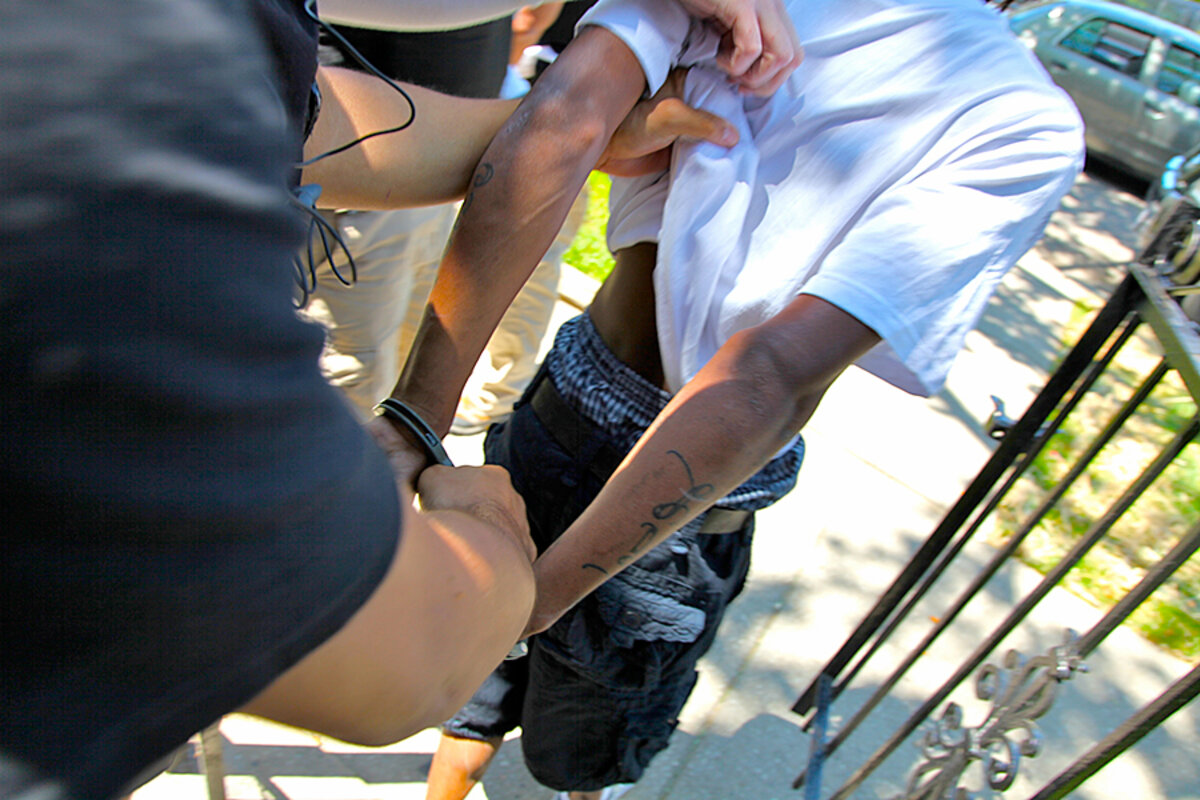Local police and Justice Department try new approach: collaboration
Loading...
Historically, local police departments have had a prickly relationship with the federal government – relationships characterized by condescension and squabbles over who gets credit for busts.
But now, as some police departments contend with both rising violent crime rates and decreasing public confidence, more are turning to federal agencies for help.
The US Department of Justice announced two new initiatives on this front earlier this week. First, the department will hold a meeting later this month with more than a dozen local law enforcement officials dealing with violent crime surges, .
Also, the department is expanding its (VRN) from five cities to 10. The network partners local law enforcement agencies with federal partners, which provide training and technical assistance tailored to the problems in those communities.
Early returns from the five original VRN cities – Chicago; Detroit; Camden, N.J.; Wilmington, Del.; and the Oakland-Richmond, Calif., area – have been broadly positive. Homicide arrests since it joined the network. Camden County Police Chief Scott Thomson has attributed a 50 percent drop in shootings and homicides over the past two years to the federal assistance. And the Justice Department helped apply for and receive $10 million in funding grants that were used to hire more police officers, purchase body cameras for all officers, and help the authorities process their backlog of rape kits.
The VRN represents another phase in the trend toward “collaborative reform” that the Justice Department has been undertaking recently. Many local police officials and criminal justice experts say such reform is preferable to previous methods of federal intervention, which involved either intrusive and burdensome monitoring or “throwing money” at departments in the form of grants that often resulted in few sustainable improvements.
“The Feds [would] come into the local jurisdiction and ... take over,” says Tod Burke, a criminal justice professor at Radford University in Radford, Va., and a former Maryland police officer. “Now what we’re seeing is cooperation, and that is super refreshing.”
Some criminal justice experts and policing groups even say these kinds of reforms could help police departments regain public trust and support. that public confidence in the police has dropped this year to its lowest point in decades, yet community relations are crucial to preventing and solving crimes.
Last month, Wilmington Police Chief Bobby Cummings credited partnerships with both the community and federal agencies for helping boost the city’s homicide arrest rate.
“By working closely together, the community and police are standing up against senseless acts of gun violence,” he said in a statement. “Maintaining this collaborative effort is important, as we look to continue cracking down on violent crime.”
On Monday, the Justice Department announced that the VRN will expand to include the following cities: Compton, Calif.; Flint, Mich.; Little Rock, Ark.; West Memphis, Ark.; and Newark, N.J.
Collaborative reform is more effective than federal agencies simply giving grants to local law enforcement, says Laurie Robinson, a criminologist at George Mason University in Fairfax, Va., who served as co-chair of the President’s Task Force on 21st Century Policing.
“Unless that [grant] money is focused in a very strategic way ... it can very easily be dissipated,” she says.
Support from technical experts can be more effective, she says. Long-term training and technical assistance from federal personnel can help police departments identify specific community problems. The departments can then turn to specific agencies for short-term tactical assistance to help address those problems. VRN cities have employed the US Marshals Service and the Bureau of Alcohol, Tobacco, Firearms and Explosives, among others.
“I [think] technical assistance is some of the best-spent federal money because it’s relatively inexpensive compared to large federal grants,” she adds.
The Camden County Police Department got de-escalation training from the US Marshals Service, as well as access to a 360-degree shooting simulator, according to Chief Thomson. Combined with other training, the measures “have significantly lowered the instances where our officers have fired their service weapons,” he writes in an e-mail.
“For an urban police department that responds to thousands of man-with-a-gun calls each year, this has made policing safer for the officers and the public,” he adds.
FBI training on how to access video from private security systems has also helped the department communicate faster with the community to catch suspects, he says.
“We are now alerting the public within hours, rather than days, which has facilitated the identification and apprehension of dozens of individuals suspected of crimes ranging from child luring to murder,” he writes, “much to the satisfaction of both the cops and the community.”
Indeed, the long-term advice from and consultation with a federal technical assistance provider can help address community concerns, says Professor Robinson.
“All of these kinds of steps and efforts toward collaboration won’t improve things overnight, but they are steps toward building a relationship over time,” she says in a follow-up email.
Even the Arkansas cities of Little Rock and West Memphis, which were included in the VRN expansion after a DOJ analysis found violent crime levels there “” of national averages, commended the Justice Department for how it is approaching reforms.
Patrick Harris, first assistant to Christopher Thyer, US attorney for the Eastern District of Arkansas, adds that collaborative reform is preferable to “throwing money [at problems] and walking away, which is what happens with grant awards.”
Thomson of the Camden County Police Department also cites downsides of the old approach, referring to “the ephemeral benefits of the traditional band-aids like grants or task force deployments.”
As a more collaborative approach has gained momentum, some cities have actively solicited federal help, especially when it comes to violent crime. Earlier this year, Baltimore asked for the Justice Department’s assistance. And in 2012, the Philadelphia police chief requested a DOJ investigation after a spike in police shootings. He praised the final report earlier this year.
As Burke of Radford University sees it, some local law enforcement agencies are warming to federal help, and in some cases are even inviting it.
“These are police agencies without an ego,” he says, noting that “the bigger issue is the community.” The approach, he adds, “may bring trust back.”





